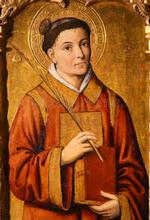On the Shores of the Ganges River
by Zsolt Aradi
The Shrine of Our Mother of Divine Grace at Mokameh lies on the southern bank of the Ganges River, about two hundred miles from Calcutta and fifty miles from Patna. This is a relatively new shrine; its construction began in 1943 and it was consecrated in 1947. However, there is a beautiful Indian legend related to this place of worship, which gives a particularly appealing atmosphere to this now holy ground.
The legend tells of a beautiful Indian princess who lost her betrothed in a hunting accident. In her grief and loneliness, she vowed to serve and to succor her people the remainder of her life. She lived in a small house on the southern bank of the Ganges and was beloved by all. Following her death, the place came to be known as Mokum Amah-- the home of the Mother. From these words came the name of Mokameh.
Today the shrine of Our Lady of Grace is at Mokameh, and those who venerate her there say that if this legend be true, it is all the more true because the shrine is now the home of another mother, Mother Mary herself. She is to them more beloved, more merciful than any princess mere legend could portray.
The church is thoroughly Hindu in style; and the figure of the Madonna, dressed in a sari, her features, the serene expression of the eyes looking inward, are strictly Hindu. The shrine is the center of great devotion; people walk from far distances to reach this religious center. During the year, organized pilgrimages arrive from Jamalpur, and especially from Patna, the chief city of the province of Bihar in northern India; this, in turn, is the heart of a mission covering a territory as large as the states of Michigan, Kentucky, Indiana and Ohio.
Every Sunday and throughout the week, the church is filled with Christian and non-Christian alike; the non-Christian prays with great fervor, occasionally leaving tributes--gifts, money and candles--just as the Christians do.
"Ninety percent of India's people are peasants who live in poverty and even in misery, but they weave their lives . . . into the country's rich tapestry of palaces and temples. Every large Hindu community has its Rajah Mahal or Royal Temple and each of these represents, in its way, the labor and care of a cathedral in the West… India's (non-Christian--ed.) pilgrimages are the greatest of the world. Pilgrimages are incorporated into the life of even the poorest outcast… For the Indian, high or low, it is of substantial importance to pray." (Thus writes Father Considine in Across a World.)
New India respects the praying Christians and its people watch with interest to see whether the Christian lives up to the principles of Christianity.
This item 3175 digitally provided courtesy of CatholicCulture.org






